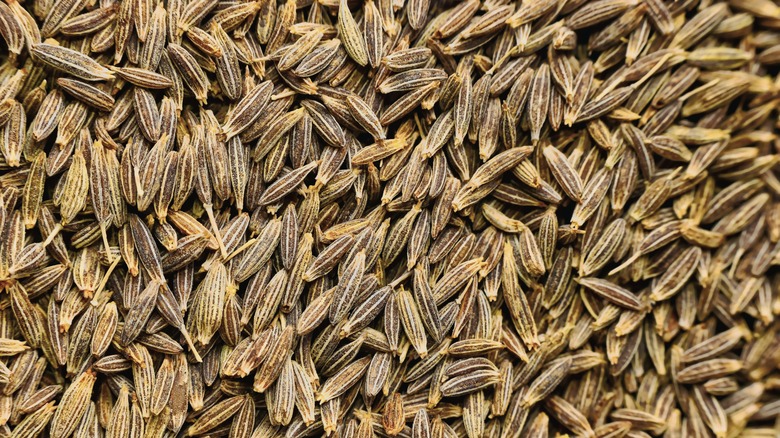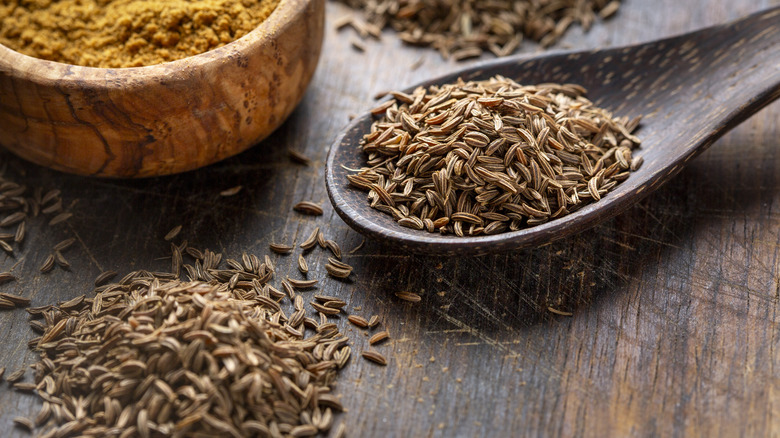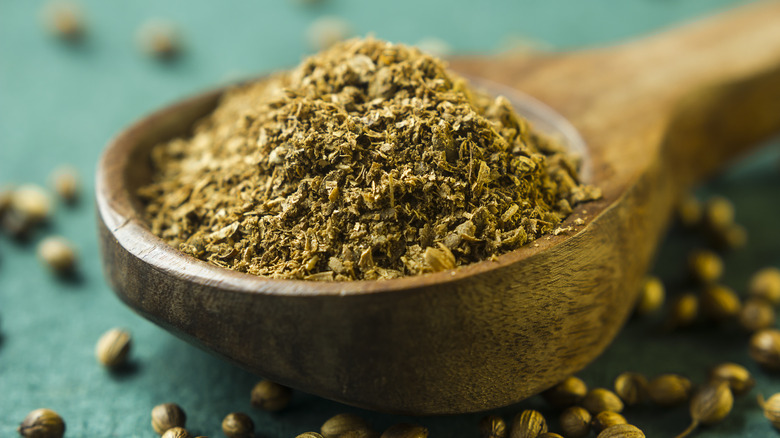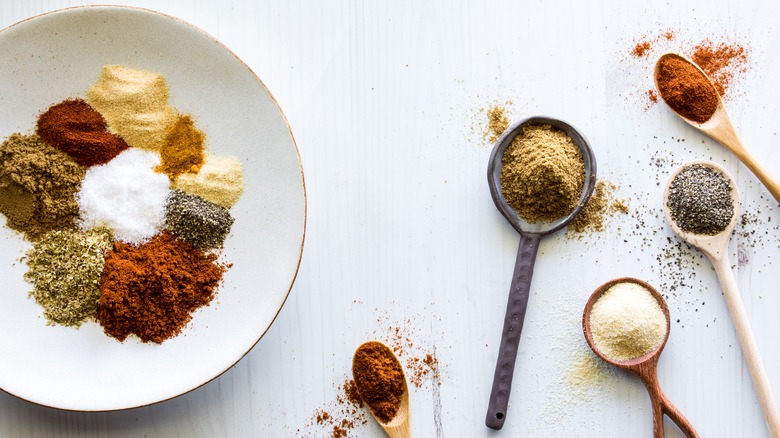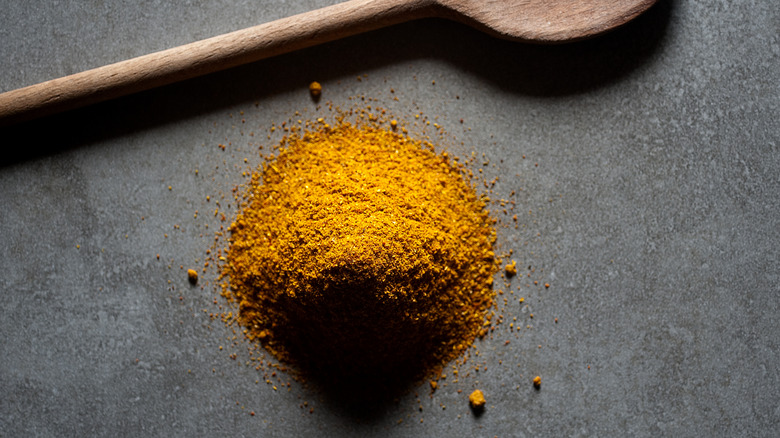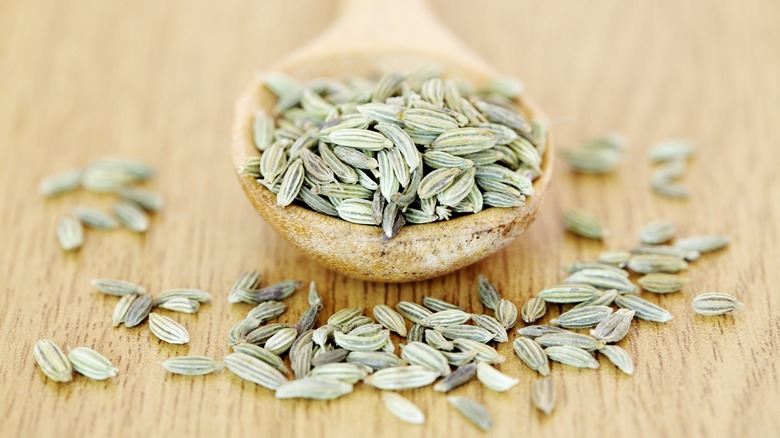The Best Substitutes For Cumin In A Recipe
Cumin is an ancient spice that has been used for its earthy, smoky, and slightly bittersweet nuttiness for millennia. Its distinct flavor profile has made it an indispensable part of the Indian, Middle Eastern, North African, and Latin American cuisines — where it is used to flavor hot soups, stews, and curries, sprinkled on top of creamy dips and sauces, added to dry spice rubs for meats and veggies, and mixed with other spices in things like chili and fajitas.
Often, those tiny seeds are toasted dry and used whole, or tempered in bubbling hot oil to give a dish dimensions of flavor and texture. They might even be crushed into coarse granules or ground into a fine powder — there are so many ways to use that one spice. But what if you're out of cumin? Is there a way to replace its slightly sweet, bitter, and peppery complexity?
Luckily, the world of cooking is full of handy little kitchen swaps. So if you don't happen to have any cumin on hand, fret not: There are plenty of other spices that can come to the rescue. The only thing to consider is whether you're replacing whole cumin seeds (which also provide a crunchy texture) or ground powder, and what you're adding that spice to. The substitute that you use will depend on it.
Use caraway seeds in place of whole cumin
If you're looking for a spice to replace whole cumin seeds that are toasted or tempered in hot oil, the best alternative is caraway seeds. Cumin and caraway seeds come from the same parsley family of plants and look nearly identical at first glance: They are both tiny, flat, and oblong-shaped seeds with a brownish hue. It is only when you look closely that you'll notice that caraway seeds are a touch darker and slightly more curved – though that won't make a significant difference in your recipe.
Simply use half the amount of caraway seeds as the whole cumin that your recipe calls for. You can always add more, of course, but it's best to taste the dish before you do so. This is because the two spices have fairly different flavor profiles. Where cumin has an earthy warmth, caraway is more citrusy with notes of licorice and anise. It's also less sharp than cumin and much milder in comparison. You might even want to consider sprinkling in a pinch of chili powder or cayenne when using caraway seeds in place of cumin. This will make up for the lost heat.
Coriander is cumin's milder cousin
You may have noticed that recipes with ground cumin often have coriander powder on the ingredient list too. This is because, much like caraway, coriander (which is not to be confused with cilantro) and cumin are botanical cousins that belong to the same family of plants. Coriander's earthy, citrus-like flavor naturally goes well with cumin, and it can replace the latter in a pinch.
Just as you would with caraway, you only need half the amount of coriander powder to replace the ground cumin in your recipe. You could even swap whole cumin with coriander seeds in equal measure — though they don't look much alike.
However, although coriander and cumin are similar in terms of flavor, the former is a comparatively mild spice. Plus, where cumin's nutty flavor is laced with a hint of bitterness, coriander is more fresh and sweet. This is why a dash of chili powder, paprika, or cayenne can do wonders here too — it will bring the subtle smoky heat that will be missing from the lack of cumin.
Sprinkle in some taco seasoning
If you don't have a jar of just ground cumin, it's a good idea to scan your pantry for any spice blends that may have those earthy seeds as a part of their ingredients instead. Take taco seasoning for instance: It almost always has a good deal of cumin inside, right alongside other spices like onion and garlic powder, red pepper flakes, and oregano.
Because taco seasoning contains a whole range of other spices as well, it works best as a cumin substitute in Mexican or Latin dishes that pair well with those ingredients — think fajitas, enchiladas, and the like. However, you might not enjoy a bowl of hummus or a warm Indian curry tasting like tacos. Additionally, taco seasoning also has a certain amount of salt, so make sure to reduce any other sources of sodium that you add on top.
You can use a 1:1 ratio to swap cumin with taco seasoning, but it's best to start with a smaller proportion — preferably with only half the quantity of taco seasoning. You can always add more later, but you don't want to risk your dish getting too salty or tasting too much like tacos instead.
Curry powder to the rescue
Another fantastic seasoning mix to use in place of cumin is curry powder — the all-in-one spice blend that is used to whip up fragrant curries in a snap. Curry powder is an ingredient that causes much confusion, thanks to the role that the British Imperial forces played in today's misunderstanding of curry. But when it comes to cumin substitutes, it's a stellar alternative that can rise to the occasion.
Curry powders are made from a mix of 20 or so herbs and spices, of which the shining ingredients are often turmeric, cumin, fenugreek, and coriander. These give the seasoning mix an earthy warmth and a sweet spiciness, which is similar to that of cumin. However, much like taco seasoning, curry powder is best used in Indian recipes — or in dishes where those 20 other spices inside will naturally blend in.
Another thing to bear in mind is that curry powder is packed with turmeric, which means that it will stain anything that it is added to with a bright yellow hue. This is why, though curry powder can be used to replace cumin using a 1:1 ratio, it's always a good idea to start small. Begin by adding only half the amount of the seasoning mix, and then taste the dish and check its color before adding more. You'll also want to reduce the amount of other spices you add on top (or skip them altogether), as curry powder already has these in some quantities.
Fennel seeds can work in a pinch
There are plenty of substitutes for ground cumin, but if it's whole seeds that you're out of (and caraway is not an option), fennel seeds can absolutely work in a pinch. These too come from the same family of plants as cumin and caraway seeds, which is why they have a similar greenish-brown, oblong appearance. You can use fennel seeds to substitute cumin the same way as you would caraway seeds — using a 1:2 ratio and then upping the quantity of the seeds gradually if you think the dish needs more.
That said, cumin is a spice unlike any other with a very distinct flavor profile that is hard to fully replace. While fennel seeds too have a sweet and earthy toastiness, they are very licorice-forward and can easily become overly sweet. Using these seeds alone may leave you sorely missing the smoky complexity of cumin, so you might want to consider adding a dash of coriander powder or paprika on top to give it the overall dish added depth.

